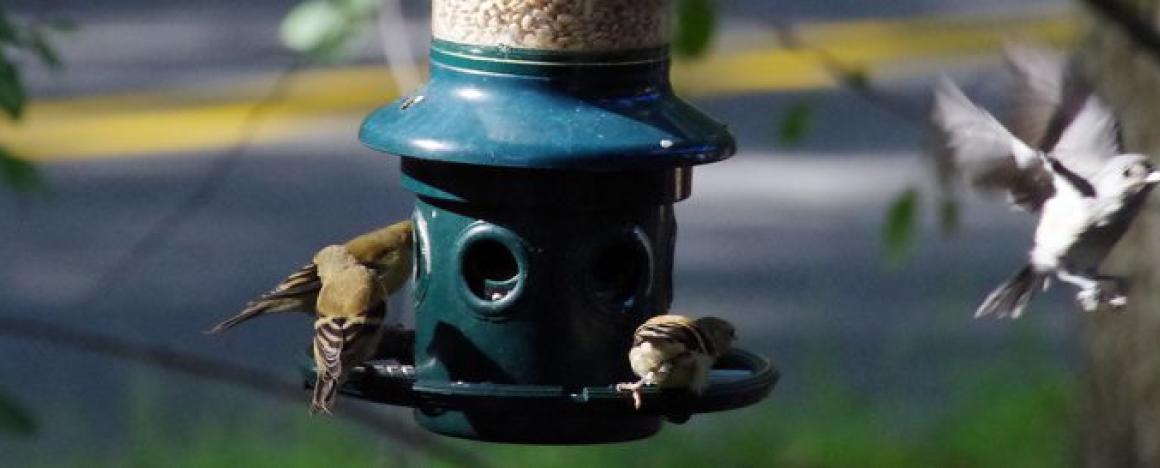Birdfeeders and Wildlife

Should I feed birds year-round?
Feeding birds year-round is not necessary. Bird feeding is most helpful at times of when birds need the most energy, such as during temperature extremes, migration, and in late winter or early spring, when natural seed sources are depleted.
Most birds don’t need your help in the summer. When they are nesting and rearing their young, many birds focus on eating insects. It is also important for young birds to learn how to find naturally occurring foods, so take a break from filling feeders in summer. NOTE: Two exceptions to this rule are hummingbirds and goldfinches. Offer your summer hummers nectar in feeders to help fuel their high metabolism, and provide nyjer seed to your goldfinches, who nest later than other birds, until thistles go to seed.
Don’t worry if you must stop feeding briefly, such as while traveling. In all but the most severe weather conditions, wild birds will find other food in your absence, particularly in suburban areas where other birdfeeders are just a short flight away.
Where should I put birdfeeders?
Birds are most likely to eat where they feel safe from predators, including free-roaming cats. Place feeders twelve feet from a brush pile, evergreen tree, or bush. Birds can quickly fly twelve feet to reach the safe cover, yet predators cannot use it to hide within striking range of the feeder. As further protection, place chicken wire or thorny branches around ground-level feeders.
Prevent window collisions by placing birdfeeders either more than 30 feet from a window or closer than three feet. A feeder that is 30 feet or more from a window is a safe distance from confusing reflections, while one within three feet prevents a bird from building up enough momentum for a fatal collision. Research specific height placement depending on the variety of bird you are attracting.
Why are different feeders placed at different levels?
Many birds will feed at more than one level, but some species have preferences.
- Ground level: mourning doves, sparrows, towhees, and juncos
- Table level: cardinals, finches, and jays
- Hanging feeders: titmice, goldfinches, and chickadees
- Tree trunks: woodpeckers, nuthatches, and wrens
What bird foods should I offer?
Birds should not be offered many of the foods humans eat. Bread (fresh or stale) provides no real nutritional value for birds; moldy bread can harm birds. Chocolate is toxic to birds, just as it is to dogs and cats (it contains theobromine). Table scraps should be avoided and they also attract mice or rats.
Winter
- Black-oil sunflower seed: high in fat so it provides good energy; seeds are small and thin-shelled enough for small birds to crack open
- White Proso Millet: high in protein content
- Peanuts: offer in tube-shaped metal mesh feeders designed for peanuts; use a feeder with smaller openings for peanut hearts
- Suet cakes: commercially made suet cakes fit the standard-sized suet feeder (you can even find vegetarian options)
- Nyjer seed: use a tube feeder with tiny holes to keep the seeds from spilling out
- Cracked corn: choose medium-sized cracked corn, as fine will quickly turn to mush and coarse is too large for small-beaked birds
Spring
- Fruit, baked and crushed eggshells and nesting materials, such as human hair, pet fur, bits of string or yarn and small strips of cloth
Summer
- Limit to nectar for hummingbirds and nyjer seed for goldfinches
Fall
- Millet, peanuts, peanut butter and suet cakes
Because bird feeders are communal, it is important to clean your birdfeeder. Disease can be a consequence associated with bird-feeding and this fact sheet of bird-related diseases and precautions can serve as a reference guide in keeping your feathered-friends healthy and active.
Sources:
http://www.humanesociety.org/animals/resources/tips/feeding_birds.html?credit=web_id86139783
http://www.massaudubon.org/learn/nature-wildlife/birds/bird-feeding-frequently-asked-questions
http://www.massaudubon.org/learn/nature-wildlife/birds/don-t-feed-the-ducks
More Resources
We have written and collected information regarding wildlife and wildlife issues you may encounter to help you better understand interacting and helping wildlife in your area.